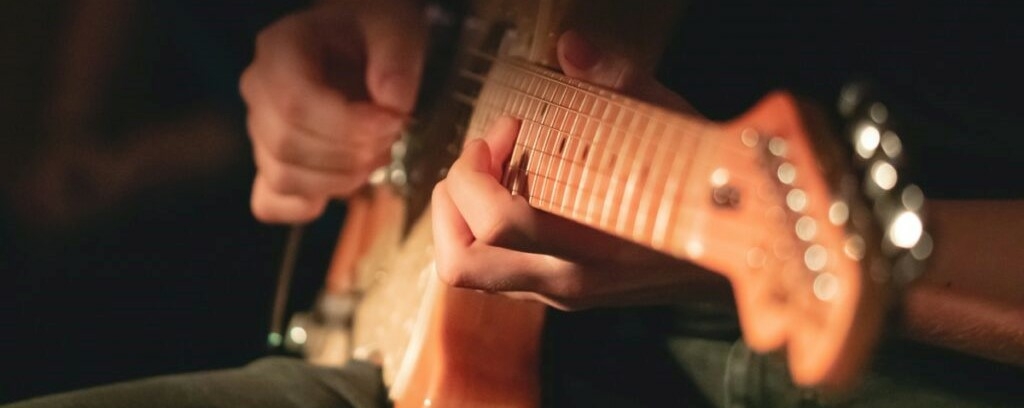Fender offer a wide variety of neck profiles to suit different hand sizes and positions. In this article I’ll take you through all the different Fender neck shapes and their thicknesses so you can figure out which is the best option for you.
Fender C vs D vs U vs V
Most Fender electric guitars have C-shape necks, but some also have D-shape, U-shape and V-shape necks.
The shape or profile of a guitar neck is independent of the thickness (aka depth). So you can get a thick C or a thin C for example, however if you were to cut a cross-section of the neck, it will still closely match the shape of the letter “C”.

C-Shape
The reason why a lot of Fenders have a C-shape neck is because it is typically the most universally comfortable and suits most hand positions. It is also often referred to as an oval shape.
There are quite a few variants of the Fender C-shape neck which have different thicknesses. For example, the Modern C neck is thinner than the ’60s C neck.
However, most C-shape necks offered by Fender are either fairly slim or moderate in thickness, there aren’t any that I would consider particularly beefy, hence they tend to suit most players.
D-Shape
In comparison to the C-shape, the D-shape has broader shoulders. The D-shape can feel a bit fuller in the hand for this reason and typically suits players who like to have their thumb resting on the back of the neck. D-shape necks are particularly popular with lead players and shredders who adopt a more classical hand position.
U-Shape
Fender also offer some U-shape necks. Whilst it is possible to get thinner U-shape necks, the ones that Fender offers are very thick and often referred to as “baseball bat” necks. These are typically only suitable for players with larger hands
V-Shape
There are also some V-shape necks on offer which like the U-shape necks, are pretty thick and typically only suit players with larger hands. Unlike the U-shape neck which suits players who like to rest their thumb on the back/side of the neck, the V-shape suits players who prefer to have their thumb over the top of the neck.
| Profile | Description | Suitable for |
| C | Oval-shaped with curved shoulders | Most hand positions |
| U | Characterised by its very high shoulders | Players who rest their thumb on the back/side of the neck |
| D | Square shoulders | Players who rest their thumb on the back of the neck |
| V | Pointed shape with shallow shoulders | Players who have their thumb over the top of the neck |
Check out my ultimate guide to neck shapes for everything else you need to know.
Comparing Popular Fender Neck Shapes
There are a lot of different Fender neck profiles available which vary in terms of their thickness and shape, and in the next section I’ll take you through each variant in more depth. However, in this section I wanted to take a look at some of the most popular profiles and how they differ.
Here’s a table comparing the 1st and 12th fret thickness of several of the most popular Fender neck profiles.
| Fender Neck Profile | Example Guitar | 1st Fret | 12th Fret |
| Modern C | American Performer Series | 0.83” | 0.91” |
| ’60s C | American Original ‘60s Telecaster | 0.83” | 0.97” |
| Deep C | American Professional II Series | 0.84” | 0.92” |
| Modern D | American Ultra Series | 0.83” | 0.87” |
| ’50s U | American Original ‘50s Telecaster | 0.94” | 1.00” |
| Soft V | American Original ‘50s Stratocaster | 0.91” | 1.00” |
As you can see from the table, the thinnest neck is the “Modern D” which is found on every American Ultra guitar. The “Modern C” is the next thinnest but can actually feel slightly thinner than the “Modern D” as it has shallower shoulders.
Check out this list of electric guitars with the thinnest necks.
Interestingly, the “Modern C” and “Deep C” Fender necks are actually quite similar in terms of thickness. The “Deep C” neck is approximately 0.01″ thicker at the 1st fret and 0.01″ thicker at the 12th fret. In comparison to the Fender Modern C, the ’60s C is roughly the same thickness at the 1st fret, but approximately 0.06″ thicker at the 12th fret.
The thickest necks that Fender offer are the ’50s U and Soft V which are approximately 1.00″ thick at the 12th fret. Unlike the Modern C which most players will find comfortable, the U and V profiles are definitely more of a love or hate.
Check out my comparison between thick and thin guitar necks.
The measurements stated above (and in the rest of the article) are an average taken from at least 5 guitars with each neck profile. Keep in mind that it’s normal for the exact thickness to vary by 0.01-0.03″ when comparing guitars with the same neck profile due to differences in the manufacturing process.

C-Shape Fender Necks
Most Fender guitars have C-shape necks.
There are actually 15 different types of Fender C-shape necks on offer and that’s not even including the custom signature model neck shapes. However, most of them have a pretty similar 1st and 12th fret thickness specification.
On average, Fender C-shape necks measure 0.83″ at the 1st fret and 0.93″ at the 12th fret. There are some necks that are slightly thicker (e.g. ’60s C thick C) and some that are slightly thinner (e.g. Modern C and Thin C).
Here is a full list of guitars which have all the different Fender C-shape necks and the thickness at the 1st and 12th fret.
Modern C:
The Modern C neck shape is the most popular by far and can be found on all models in the American Performer, Player, and Player Plus series. The average width is 0.83″ at the 1st fret and 0.91″ at the 12th fret. It can be found on the following guitars.
- American Performer (all models)
- Player (all models)
- Player Plus (all models)
- Vintera ’50s Stratocaster Modified
- Vintera ’60s Stratocaster Modified
- Vintera ’60s Jaguar Modified
- Vintera ’60s Jazzmaster Modified
Mid ’60s C and ’60s C:
I’ve grouped these two neck profiles because they are virtually identical in terms of shape and thickness. The ’60s C/ mid-’60s C profile is approximately 0.83″ thick at the 1st fret and 0.97″ thick at the 12th fret.
Mid ’60s C:
- Vintera ’60s Stratocaster
- Vintera ’60s Jaguar
- Vintera ’60s Jazzmaster
- American Original ’60s Jazzmaster
’60s C:
- American Original ’60s Telecaster
- Vintera ’60s Telecaster Modified
- Vintera ’60s Mustang
Thin C:
The thin C neck profile is only found on two guitars in the Fender range. It is very similar to the modern C, except slightly thinner at the 12th fret on most models. It is roughly 0.83″ thick at the 1st fret and 0.90″ thick at the 12th fret.
- Vintera ’70s Telecaster Deluxe
- Vintera ’70s Telecaster Custom
Other C-Profiles:
The following C-shape profiles are only seen on one guitar model in the Fender range (excluding custom shop and signature guitars). Here is a table showing the different profiles and thicknesses.
| Fender C-Shape Neck | Guitar | 1st Fret Width | 12th Fret Width |
| Deep C | American Professional II Series | 0.84” | 0.92” |
| C-Shape | Contemporary | 0.83” | 0.86” |
| 1963 C | American Vintage 1963 Telecaster | 0.83” | 0.98” |
| 1977 C | American Vintage 1977 Telecaster | 0.86” | 0.93” |
| 1972 C | American Vintage 1972 Thinline Telecaster | 0.79” | 0.93” |
| 1975 C | American Vintage 1975 Telecaster Deluxe | 0.80” | 0.95” |
| 1961 C | American Vintage 1961 Stratocaster | 0.82” | 0.93” |
| 1973 C | American Vintage 1973 Stratocaster | 0.85” | 0.91” |
| 1966 C | American Vintage 1966 Jazzmaster | 0.83” | 0.95” |
| Thick C | American Original ‘60s Stratocaster | 0.84” | 0.97” |
| Early ‘60s C | Vintera ’60s Telecaster Bigsby | 0.83” | 0.91” |

D-Shape Fender Necks
There are only two D-shape necks available from Fender at the time of writing:
- Modern D (on all Fender American Ultra guitars)
- Augmented D (on all Fender American Ultra Luxe guitars)
The “augmented D” profile on the American Ultra Luxe guitars is slightly fuller at the 12th fret compared to the “modern D” on the American Ultra guitars. At the 1st fret, the profiles are the same thickness on average.
| Fender D-Shape | 1st Fret Thickness | 12th Fret Thickness |
| Modern D | 0.83″ | 0.87″ |
| Augmented D | 0.83″ | 0.89″ |
U-Shape Fender Necks
There are only three U-shape Fender necks available on the standard (non-custom shop/ signature) guitars and they are each only found on one Telecaster version:
- 1951 U (on the American Vintage II 1951 Telecaster)
- 1952 U (on the American Original ’50s Telecaster)
- Early ’50s U (on the Vintera ’50s Telecaster)
All these necks are quite thick and are representative of the “baseball” Telecaster neck of the ’50s.
They are all a very similar at the 12th fret, but the 1951 U is the thinnest at the 1st fret, followed by the Early ’50s U and finally the 1952 U neck is the thickest.
| Fender U-Shape | 1st Fret Thickness | 12th Fret Thickness |
| 1951 U American Vintage II 1951 Tele | 0.89″ | 1.00″ |
| 1952 U American Original ’50s Tele | 0.94″ | 1.00″ |
| Early ’50s U Vintera ’50s Tele | 0.92″ | 0.99″ |
V-Shape Fender Necks
There are only two V-shape Fender neck profiles:
- 1951 V (on the American Vintage II 1957 Stratocaster)
- Thick Soft V (on the American Original ’50s Stratocaster and Vintera ’50s Stratocaster)
Both of these V-shape necks are pretty thick, although the “thick soft V” on the American Original ’50s and Vintera ’50s Strat is a touch thicker compared to the 1951 V on the American Vintage II 1951 Stratocaster.
| Fender V-Shape | 1st Fret Thickness | 12th Fret Thickness |
| 1957 V | 0.89″ | 0.99″ |
| Thick Soft V | 0.91″ | 1.00″ |
Check out my complete guide to fret sizes e.g. jumbo, medium jumbo, vintage, narrow tall etc.
